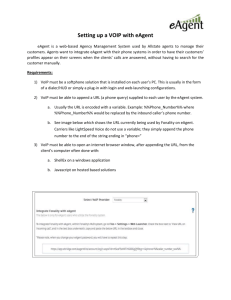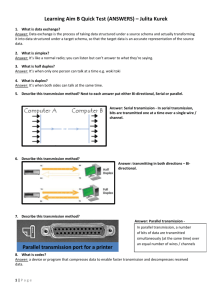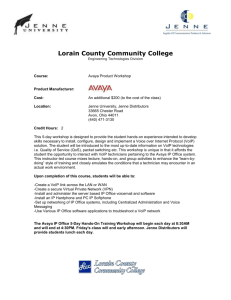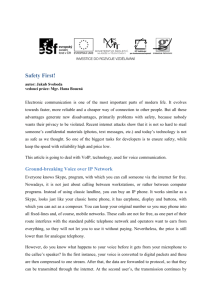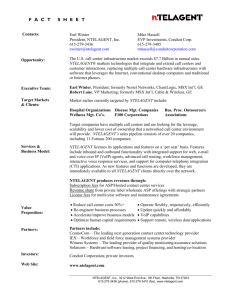Request for Proposal for Telephone System
advertisement
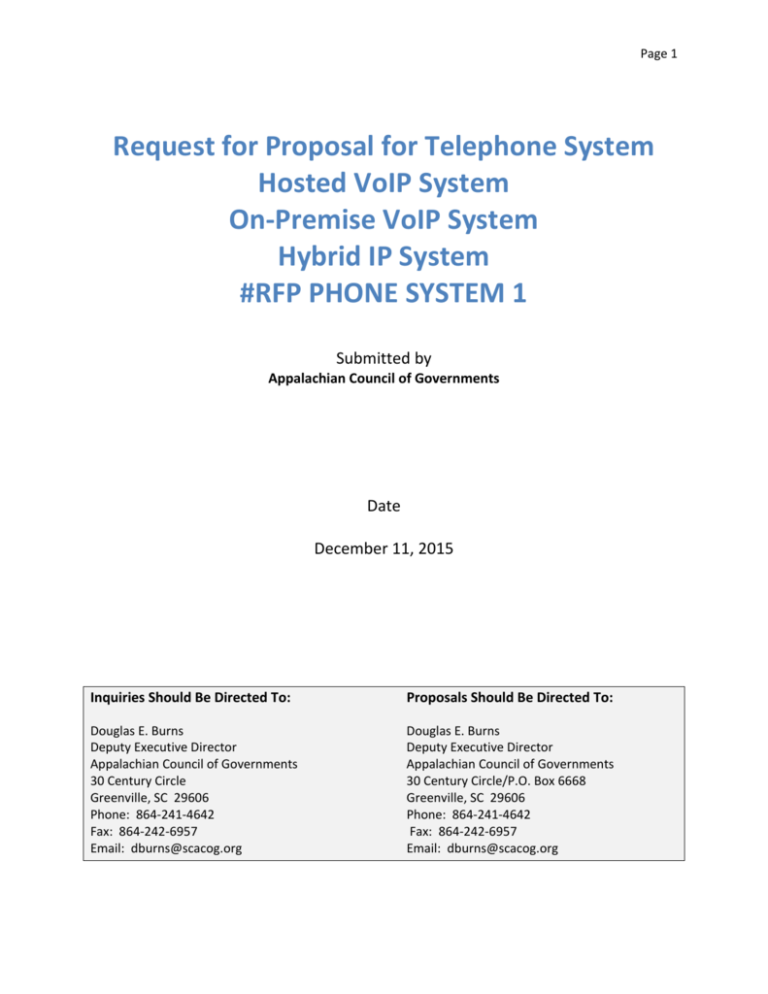
Page 1 Request for Proposal for Telephone System Hosted VoIP System On‐Premise VoIP System Hybrid IP System #RFP PHONE SYSTEM 1 Submitted by Appalachian Council of Governments Date December 11, 2015 Inquiries Should Be Directed To: Proposals Should Be Directed To: Douglas E. Burns Deputy Executive Director Appalachian Council of Governments 30 Century Circle Greenville, SC 29606 Phone: 864‐241‐4642 Fax: 864‐242‐6957 Email: dburns@scacog.org Douglas E. Burns Deputy Executive Director Appalachian Council of Governments 30 Century Circle/P.O. Box 6668 Greenville, SC 29606 Phone: 864‐241‐4642 Fax: 864‐242‐6957 Email: dburns@scacog.org Page 2 Table of Contents A. General Information ............................................................................................................................... B. Purpose .............................................................................................................................................. C. Instructions on Proposal Submission ................................................................................................. D. Evaluation Criteria.............................................................................................................................. E. Proposal Content ............................................................................................................................... F. System Requirements and Implementation ...................................................................................... II. SCOPE AND SPECIFICATIONS .................................................................................................................. A. Scope of Future Telephone System ................................................................................................... B. Description of Current Telephone System ......................................................................................... C. Description of Network ...................................................................................................................... III. VENDOR BACKGROUND ...................................................................................................................... A. Company Information ........................................................................................................................ B. Vendor References............................................................................................................................. IV. BUSINESS TELEPHONE SYSTEM PRODUCT REQUIREMENTS ............................................................... A. General Requirements ....................................................................................................................... B. System Requirements ........................................................................................................................ C. System Architecture ........................................................................................................................... D. System Administration ....................................................................................................................... E. Voice Over Internet Protocol (VoIP) Features ................................................................................... F. Session Initiated Protocol .................................................................................................................. G. Call Handling ...................................................................................................................................... H. Integration and Customization .......................................................................................................... I. Messaging and Voice Mail Systems ................................................................................................... J. Reporting ........................................................................................................................................... K. Station Hardware ............................................................................................................................... L. Functionality ...................................................................................................................................... M. System Reliability ............................................................................................................................... N. E911 Services ..................................................................................................................................... V. INSTALLATION SERVICE AND MAINTENANCE ......................................................................................... A. Installation Service ............................................................................................................................. B. Warranty Service................................................................................................................................ Page 3 Page 4 I. GENERAL INFORMATION A. Appalachian Council of Governments Mission The Appalachian Council of Governments (ACOG) is a political subdivision of the State of South Carolina. Founded in the mid 1960s, ACOG is a regional organization that represents the six counties of Upstate South Carolina (Anderson, Oconee, Pickens, Greenville, Spartanburg and Cherokee counties.) ACOG exists to assists these local governments in many ways including Government Services, training, grants administration, planning, economic development, aging and workforce development. ACOG works very closely with local, state and federal agencies to help improve the quality of life for the residents of Upstate South Carolina. Company Background The Appalachian Council of Governments (ACOG) was founded in 1965, and is one of ten regional council of governments in the State of South Carolina. Originally established for regional planning issues, over the years the organizations has grown and developed and is now involved in most aspects of improving the quality of life in this region including planning, training, aging, economic development, demographics, mapping, government services, grant writing and administration, etc. Faculty and Staff ACOG is blessed with a small but very qualified staff. ACOG employs a staff of just shy of fifty employees. Most are well educated (Masters degrees) and very versed in their fields of specialty. There are six divisions within the organization each headed by a director; with the entire organization led by the Executive Director. B. Purpose The Appalachian Council of Governments is looking to replace its current, outdated system with a new and improved one. ACOG seeks proposals on the type of system that best suites its needs. Systems under consideration include a hosted VoIP system, an on‐premise VoIP system and a hyrbrid system. ACOG seeks a system that is functional in terms of our current needs, but that can easily and inexpensively be updated/upgraded to address future needs. The selected Vendor will be our primary source for the following: Business telephone system hardware, software and voice mail equipment Page 5 Installation and configuration services for this equipment Training of users and administrators Maintenance of purchased and installed equipment and software Upgrades to the installed systems as necessary Coordination between System and Services Ensuring there are no other ancillary costs other than those specified in the proposal C. Instructions on Proposal Submission 1. Written Questions and Inquiries All requests for information should be directed to: Doug Burns, Deputy Executive Director Appalachian Council of Governments P.O. Box 6668 Greenville, SC 29606 864‐241‐4642 dburns@scacog.org www.scacog.org 2. Closing Submission Date Proposals must be submitted and received no later than 12:00 p.m. on January 15, 2016 . 3. Condition of Proposal All costs incurred in the preparation of a proposal responding to this RFP will be the responsibility of the Vendor. During the evaluation process, the Appalachian Council of Governments reserves the right to request additional information or clarification from the Vendor to allow for correction of errors and omissions. 4. Instruction to Prospective Contractors a. Proposal Instructions Submit one original and five (5) copies of the response. Each prepared response shall be submitted in a sealed envelope. The envelope must be addressed to the following and must include the label as indicated below. Name: Douglas E. Burns Deputy Executive Director Appalachian Council of Governments 30 Century Circle/P.O. Box 6668 Page 6 Greenville, SC 29606 It is important that the Vendor’s proposal be submitted and clearly marked in the lower left‐hand corner with the following information: Appalachian Council of Government ‐ Proposal For phone system ‐‐#RFP PHONE SYSTEM 1 Due: January 15, 2016 It is the responsibility of the Vendor to ensure that the proposal is received by the date and time specified above. Late proposals will not be considered. A copy can be sent electronically to dburns@scacog.org with the subject line of “Proposal – for phone system”. 5. Contract Overview The proposal should include a contract for all proposed equipment and services including coordination between the system and the available services. The contract must include all costs for the proposal, and there shall not be any additional ancillary costs. If the Vendor does not wish to submit an actual contract with the proposal, due to different alternatives proposed and pending choices from those alternatives, a sample contract should be submitted with the proposal. The Contract shall include all insurance provided, surety bonds and costs, etc. The contract must state that the vendor provides its own worker’s compensation insurance or is not required to provide same. 6. Contract Term and Cost of Ownership All equipment, software, licensing and maintenance pricing and negotiations or variations must be clearly stated. All pricing and negotiations must include both a five (5) and seven (7) year analysis of the Total Cost of Ownership. It shall include the costs of any necessary upgrades at ACOG to make the system operational. There shall be no additional costs associated with the purchase, installation and/or operation of the proposal. 7. Right to Reject Page 7 The Appalachian Council of Governments reserves the right to reject any and all proposals received in response to the RFP. A contract for the accepted proposal will be based upon the factors described in this RFP. D. Evaluation Criteria All responses to this RFP will be evaluated based on, but not limited to, the following factors: • Cost • Functionality of standard equipment and features to meet our specific needs • Availability of additional capabilities to add as needed • System growth and expansion • Ability to save communications costs by using Internet Technologies • Ease of use • Product quality, reliability, and warranty plan • Vendor qualifications • Overall reputation in the industry • Experience and expertise with the product being offered • Service and support resources, including training by vendor for the installation and maintenance • Certified vendor relationship with product manufacturer • References where similar systems have been installed • Points will be established to each of the above at a later date prior to the evaluation to ensure equal competition between vendors. E. Proposal Content Proposals should include the following information: • Vendor Overview • Vendor Qualifications • Vendor Partners for the solution proposed • Vendor Experience in implementing similar proposed systems • Vendor References (include a minimum of 3) • Overview of Vendor IT staff, qualifications and certifications • Software and Hardware: Clearly specify each piece of hardware (server, switches, proprietary hardware) with model numbers and software with version numbers. List must be complete and include all costs Page 8 Planned/warranted lifespan (based on the manufacturer or creator’s intention to support) of hardware All quantities of equipment (hardware, software, licenses) Licenses with costs Implementation plan and costs Risk assessment Failover option or plan Maintenance or support contracts, etc. Maintenance requirements and size of windows to perform maintenance Migration path of upgrades or updates and their respective impact to operations Skill sets recommended to support proposed hardware and software Readiness Statement as to the state of ACC’s data network Assumed infrastructure needed based on the manufacturer or creator’s recommendations F. System Requirements and Implementation The Appalachian Council of Government’s staff and the Vendor will work toward implementing a VOIP/hybrid solution system under the following: • ACOG will consider all Vendor hardware proposals, but purchase of equipment for future replacement of phones must not be limited to a single vendor resource. • All equipment will include all necessary power cords and cables that may be needed. • Proposal shall include all costs associated with the purchase, installation, connection and/or maintenance of the proposal. No additional equipment, infrastructure or costs may be added at a later date. The proposal must be complete. • Any company submitting a proposal is responsible for doing its due diligence to anticipate all costs associated with the proposal. • ACOG, at its own discretion, has the right to accept or reject any proposal that does not meet the requirements of this RFP. Page 9 II. SCOPE AND SPECIFICATIONS A. Scope of Future Telephone System The purpose of the RFP is to obtain the installation and maintenance of a unified communications system. ACOG is looking to purchase/lease a new VoIP/hybrid system to replace our existing NEC system. ACOG wants a system that is current and functional for a business of our size and type, but further a system that can quickly and inexpensively be updated to accommodate changes in technology and needs. ACOG seeks a system that can be used in the office, on softphones, potentially from one’s home and in other locations. B. Description of Current Telephone System The Appalachian Council of Governments currently utilizes a sixteen (16) year old NEC, analog system with a T‐1. C. Description of Network Each office has a 4‐port wall panel that is used to connect Ethernet PC(RED), phone(BLUE) and GREEN, BLACK which can be used for Ethernet. All of the offices are connected thru Ethernet (CAT5) back into the computer room network panels. All the network cables are connected into a CISCO 2960 Managed Switches – into a CISCO 1900 Router/Fiber Optic which takes you to the outside world. (A schematic is available upon request.) III. VENDOR BACKGROUND A. Company Information 1. List your company’s legal name, address, and telephone number. 2. How long has your company been in business? 3. How long has your company or division been providing business telephone systems and related equipment? 4. Indicate whether your company is the manufacturer or the distributor of the proposed equipment. If you are a distributor, describe the terms of your agreement with the Page 10 manufacturer, the manufacturer’s level of support, and what contingencies they have in place should your company fail to continue to support the product or service for any reason. 5. Do you install the product or use business partners? 6. Do you maintain the product or use business partners? 7. How many employees do you have? 8. How many technicians are certified on the proposed equipment? 9. If this is a hosted off‐premise system, describe your sites and alternate site locations used for redundancy. 10. Provide a financial statement for your organization. 11. Describe your plans for future product development and support. 12. Explain why your solution is a best fit for our company. B. Vendor References Provide a minimum of three (3) references for customers with operations similar to ours that use the equipment being proposed. Include contact names, telephone numbers, and addresses. Page 11 IV. BUSINESS TELEPHONE SYSTEM PRODUCT REQUIREMENTS A. General Requirements 1. Please provide product descriptions and brochures for the proposed business telephone system, voice mail system, telephone sets, attendant consoles, and other related equipment. . B. System Requirements 1. System Capacities – The VoIP/ hybrid‐IP telephone system must be scalable via different versions that are applicable to different business needs. Describe the scalable capacities available on the proposed hybrid‐IP telephone system. 2. Station Configuration Flexibility – Confirm the proposed VoIP/hybrid‐IP telephone system’s support for all of the following types of telephones: IP, digital, analog, wireless, and SIP endpoints. 3. Trunk Flexibility – The proposed VoIP/hybrid‐IP telephone system must provide support for SIP trunking. 4. Hearing Aid Compatible – All proposed station equipment must comply with rules adopted by the Federal Communications Commission that specify all telephones in workplaces of 20 employees or more must be hearing aid compatible. Describe the attributes of the proposed system and telephone sets as it relates to this. C. System Architecture 1. Infrastructure Review It will be the responsibility of the Vendor to assure that they have performed adequate network performance reviews, assessments, or a site visit, in order to make assurances that Page 12 the proposed VoIP/hybrid‐IP telephone system will function at optimal performance under the current network structure. It is expected that the Vendor “Shall Provide” a readiness statement as to the capabilities of the current data network readiness to provide the support necessary for the proposed system. Provide readiness statement here. 2. System Architecture and Design Describe the proposed VoIP/hybrid‐IP telephone system design and space required. What is the maximum user capacity of the proposed IP communications system? D. System Administration 1. Administration – Provide a detailed description of the configuration and management tools available on the proposed VoIP/ hybrid‐IP telephone system. 2. Remote Monitoring – The proposed VoIP/hybrid‐IP telephone system must be capable of remote monitoring. 3. Centralized Licensing – The proposed VoIP/ hybrid‐IP telephone system should include the ability to assign certain user solutions to certain users within the network. 4. Long Distance Tracing and Reporting – The proposed VoIP/hybrid‐IP telephone system must allow assigning authorization codes to individuals, projects, and customers in order to charge expenses directly to the appropriate departments and to control access to long‐ distance facilities beyond normal class of service restrictions. Can the proposed telephone system track long distance calls and provide reporting for individual extensions? 5. Security – How is security provided to prevent unauthorized access to the administration application? Can some administrators be defined with “view‐only” permissions? Page 13 E. Voice over Internet Protocol (VoIP) Features 1. Voice Communication Features – Provide an overview list of voice communication features available on the proposed VoIP/hybrid‐IP telephone system. The list should include at a minimum PBX functionality, number of extensions supported, types of telephones supported, conferencing capacities, call routing, support for H.323 and SIP, trunk interfaces, and networking. 2. Data Communication Features – Provide an overview list of data communication features available on the proposed VoIP/hybrid‐IP telephone system. The list should include at a minimum firewall capabilities, routing and addressing protocols, remote access, Ethernet ports, and LDAP support. 3. Virtual Private Network (VPN) – Is a VPN required to support remote IP telephone communication via the private IP network or the Internet? What is gained/lost by using a VPN? 4. IP Protocols Supported ‐ Which IP protocols does the proposed system use with its IP telephones (MEGACO, MGCP, H.323, SIP, SCCP, etc.)? What are the advantages/disadvantages? 5. Softphone Capabilities – The proposed VoIP/hybrid‐IP telephone system should have the ability to provide softphone extensions that reside on our employees’ personal computers. These extensions should provide an equal or better level of functionality as the proposed hardware station equipment. 6. Smartphone & Tablet Capabilities – The proposed VoIP/hybrid‐IP telephone system should have the ability to be used/accessed from a smartphone and/or a tablet device. 7. VOIP Network Readiness Assessment – Describe any network readiness assessment required or recommended to make sure our network will handle the addition of voice traffic over the IP data network. Do you provide this service? Page 14 F. Session Initiated Protocol 1. Does the proposed VoIP/ hybrid‐IP telephone system support SIP? 2. Does the proposed VoIP/hybrid‐IP telephone system require SIP gateways? 3. Does the proposed VoIP/ hybrid‐IP telephone system support standard SIP‐enabled hardware? G. Call Handling 1. The proposed VoIP/hybrid‐IP telephone system must permit station users to forward incoming calls to another phone of their choice based on busy, no answer, and all calls conditions. 2. Any station in the proposed VoIP/ hybrid‐IP telephone system must be able to park a call for retrieval at another station. 3. The proposed VoIP/hybrid‐IP telephone system must allow station users to answer calls intended for other stations within a common call pickup group. 4. Station users of the proposed VoIP/hybrid‐IP telephone system must be able to transfer a call in progress to an internal extension or external number without attendant intervention. 5. Can queues be configured on demand while calls are in queue? 6. Can the proposed VoIP/hybrid‐IP telephone system announce the estimated wait time? 7. Can the proposed VoIP/hybrid‐IP telephone system announce the user’s position in the queue? 8. Does the proposed VoIP/hybrid‐IP telephone system allow the users to leave a message rather than wait in the queue? 9. Does the proposed VoIP/hybrid‐IP telephone system support real‐time monitoring? 10. Does the proposed VoIP/hybrid‐IP telephone system offer real‐time graphs and statistics? Page 15 H. Integration and Customization 1. Does the proposed VoIP/hybrid IP telephones system support integration with email? 2. Does the proposed VoIP/hybrid‐IP telephone system support integration of the phone system with other business applications? 3. Does the proposed VoIP/hybrid‐IP telephone system offer database options for IVR applications? 4. Does the proposed VoIP/hybrid‐IP telephone system provide integration to emergency communication software? 5. The proposed VoIP/hybrid‐IP telephone system must support voice paging via paging equipment. If management permits, station users may dial an access code for a connection to the paging equipment. I. Messaging and Voice Mail Systems 1. Does your solution provide a single‐user interface for email, voicemail and fax messages? Describe the solution or unified communication capabilities of the system. 2. Describe the architecture of the proposed voicemail solution, including how voicemail is accessed by users from their extension remotely, from their mobile devices and from their desktop computer. 3. Can users have their phone calls forwarded to other numbers when they are not available? 4. How are users notified of new voicemail messages or faxes? 5. Does your solution offer a mobile access? 6. How many users are supported by the proposed voice mail system? J. Reporting 1. Does your solution provide basic call reporting for billing and accounting purposes? 2. Does your solution provide a more robust call reporting system? Page 16 K. Station Hardware 1. Describe the supported station IP/digital phones for your system. 2. Specify the power requirements for each station IP phone and analog/digital phone. 3. Are headsets available? 4. Does the proposed VoIP/hybrid‐IP telephone system support the use of phones other than IP (i.e., digital and/or analog)? L. Functionality 1. Conference – The proposed VoIP/hybrid‐IP telephone system must provide the ability to initiate a conference call with a minimum of five (5) additional parties. Please indicate the maximum number of simultaneous parties that may be included in a conference call with a minimum loss of audio call quality. 2. Stored Numbers – The proposed VoIP/hybrid‐IP telephone system must have the ability to store a list of frequently called numbers and make those available on a systemwide basis to station users. 11. Call on Hold – Describe the proposed VoIP/hybrid‐IP telephone system’s ability to provide waiting callers music‐on‐hold. 3. Status/Availability Indication (presence) – Describe the proposed VoIP/hybrid‐IP telephone system’s status/availability feature. 4. Direct Dialing – The proposed VoIP/ hybrid‐IP telephone system must support direct dialing to extensions from outside callers. Page 17 5. User Mobility – Does the proposed VoIP/hybrid‐IP telephone system have the ability to allow users to log in as their designated extension from any telephone? 6. Single Number Reach – Does your solution have the ability to simultaneously ring a user’s IP desk phone, mobile phone, and other user‐defined devices? Describe the capability. M. System Reliability 1. How does the system provide reliability for voice services? Explain how it avoids any single point of failure (single site as well as multi site). 2. For redundancy purposes, where are copies of the firmware and configurations stored on the proposed VoIP/ hybrid‐IP telephone system? N. E911 Services 1. Is the proposed system in compliance? Does it provide E911 reporting capabilities? V. INSTALLATIONSERVICEANDMAINTENANCE A. Installation Service 1. Explain in detail the installation plan. B. Warranty Service 1. Maintenance and Warranty: A complete maintenance and warranty agreement, as well as quote, must be included as part of the bidder’s proposal. 2. Defective Parts 3. Service Calls – What are your response times for: • Complete system failure. Please define system failure. • Major service malfunction. Please define a major failure. • Minor service malfunction. Please define a minor malfunction. • Station outages. Please define a station outage. Page 18 Signature: Date ………………………………………………………………………………………………………………………………… Signature of Vendor’s Representative ………………………………………………………………………………. Printed Name and Title ……………………………………………………………………………………………………… Vendor Firm Name ………………………………………………………………………………………… Vendor Mailing Address ………………………………………………………………………………………… Vendor City/State/Zip ………………………………………………………………………………………… Vendor Telephone …………………………………………………………………………………………
